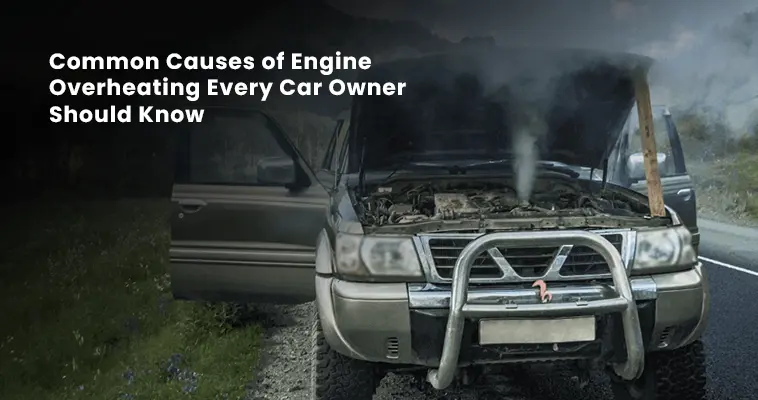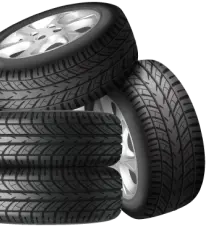Modern cars are built to perform reliably under various conditions, but regular maintenance is essential to prevent issues like engine or car overheating. However, many car owners overlook early warning signs until the engine warning light or smoke is visible, indicating a more significant issue. Understanding the common causes of overheating, such as low coolant levels, faulty thermostats, or malfunctioning fans, allows you to address these issues on time.
This blog outlines the main causes of car engine overheating and provides essential information to help you identify and address the issue effectively.
How to know if your car’s engine is overheating when driving?
Here are key signs that your engine may be overheating:
- The temperature gauge moves into the red zone or higher than usual
- Steam or smoke coming from under the hood
- A strong, sweet smell inside or outside the car (coolant leak)
- Noticeable loss of engine power or irregular engine performance.
- The heater either blows excessively hot air or fails to operate effectively.
- A warning light or engine light comes on the dashboard.
What does it mean when the car engine light comes on?
The car engine light on your dashboard indicates a problem with the engine or its systems. It can activate for various reasons, but engine overheating is among the urgent causes. When a light appears due to rising temperature, have your car inspected without delay to prevent damage.
Common reasons why your car is overheating
Here are the most common issues that lead to overheating:
1. Low coolant levels
Coolant, also called antifreeze, controls your car’s engine temperature to prevent overheating. Over time, evaporation or minor leaks lower coolant levels, which can cause the engine to overheat.
Read our guide on how to detect a coolant leak before it damages the engine to prevent costly repairs.
2. Faulty thermostat
The thermostat controls coolant flow through the engine. If the thermostat is stuck, it blocks coolant circulation and causes the engine to overheat. This issue is more common after 100,000 km or in older cars.
3. Radiator problems
The radiator cools the fluid circulating through the engine. When it becomes clogged, cracked, or begins to leak, the engine cannot maintain a stable temperature. You may observe steam or unusual odours emanating from under the bonnet. In most cases, radiator issues show up after 120,000 km; however, poor maintenance can accelerate problems.
4. Broken water pump
The water pump circulates coolant throughout the engine. When it fails, coolant cannot flow, causing the engine to overheat. Generally, water pumps wear out between 96,000 and 145,000 km. If you hear grinding noises near the front of the engine, it may indicate a failing water pump.
It’s not safe to drive with a failed water pump. You risk damaging the head gasket or warping the engine block.
5. Cooling fan failure
The electric fan behind the radiator activates when the engine temperature rises. If the fan malfunctions, the engine can’t cool efficiently. While this issue has less impact on highway driving, it can cause significant overheating problems in city traffic.
If you notice any of these signs, it’s essential to consider car repair near you. A local mechanic helps you manage the problem with ease and reduces the risk of it escalating.
What should you do if your car starts overheating?
Most car mechanics recommend the following steps if your car starts to overheat:
- Turn off the car’s air conditioning and switch on the heater to help draw excess heat away from the engine.
- Pull over safely and shut off the engine.
- Wait at least 15–30 minutes before opening the bonnet.
- Do not open the radiator cap while the engine is hot—it can cause burns.
- Check the coolant level, but only if it is safe
- Contact a reliable car mechanic to inspect the car and arrange towing if needed.
When should you get an inspection?
Here’s a basic timeline:
- Every 10,000 km: General inspection and fluid top-up
- Every 40,000–50,000 km: Coolant flush and radiator check
- After 100,000 km: Inspect thermostat, hoses, and water pump
- After 120,000 km: Full cooling system inspection recommended
If your car overheats regularly or you notice the engine light, it is recommended to contact a car mechanic in Melbourne to avoid major problems and costly repairs.
How BCS Workshop handle engine problems?
We follow a simple process customised to identify and resolve issues efficiently:
- Issue Check: Identify signs of overheating.
- Visual Inspection: Check coolant levels, hoses, and radiator.
- Computer Diagnostic Test: Scanning the system to detect issues.
- Service Plan: Outline the required repairs or maintenance.
- Repairs: Fix the issue based on priority and parts availability.
- Final Check: Ensuring the engine functions optimally before return.
At BCS Workshop, we handle car overheating and engine light issues for a wide range of vehicle brands, including Audi, BMW, Ford, Honda, Kia, Mazda, Mercedes, Mitsubishi, Nissan, Subaru, Toyota, Volkswagen, Volvo & more. We provide reliable car repairs near you, ensuring your car remains efficient, cool, and protected.
Take away
The engine light on your car’s dashboard is an important warning, especially when linked to car overheating. Common causes include low coolant levels, faulty thermostats, radiator issues, water pump failure, and cooling fan problems. Regular maintenance, such as coolant flushes every 40,000 to 50,000 km and thorough cooling system inspections after 100,000 km, helps prevent these issues. If you notice increasing engine temperatures or a persistent warning light, stop the car safely and contact an experienced mechanic.
At BCS Workshop, we perform comprehensive car diagnostic tests near you to identify issues causing engine overheating. Our experienced mechanics then provide effective repairs to resolve these problems.
Book your service today.









